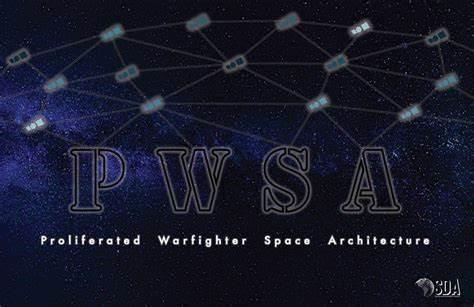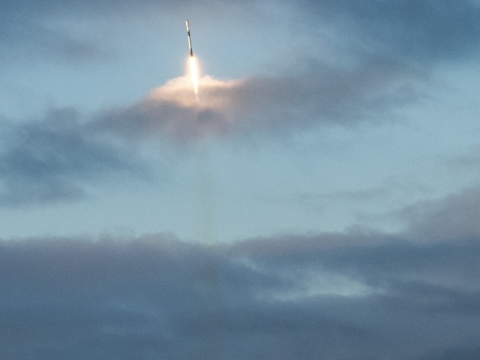Space Development Agency Pursues JADC2 Transit Layer
On October 30, the Space Development Agency (SDA) awarded contracts totaling $1.3 billion to Redondo Beach, California-based Northrop Grumman Space Systems and Denver-based York Space Systems, which will build and operate the agency’s so-called Tranche 2 Transport Layer (T2TL)-Alpha variant prototype constellation that includes 100 satellites. The constellation, which is part of the Proliferated Warfighter Space Architecture, is a key space component of the data relay and tactical communications infrastructure needed for Joint All-Domain Command and Control (JADC2).
The two contracts were both other transaction authority prototype awards, firm-fixed-price vehicles, with $732 million going to Northrop and $617 million for York. Given the urgent need to build the Proliferated Warfighter Space Architecture, the contracts also include on-time incentive payments.
“The T2TL-Alpha constellation will provide global communications access and deliver persistent, regional, and encrypted connectivity to support missions like beyond-line-of-sight targeting and missile warning and missile tracking of advance missile threats as part of the Proliferated Warfighter Space Architecture,” the agency indicated.
The agency plans to have the first orbital plane of the T2TL-Alpha constellation launched by the companies no later than September 2026.
Tranche 2 includes the low-Earth orbit tracking layer infrastructure that will provide global surveillance and targeting as a service with a 24/7/365 missile warning, missile tracking and missile defense capability integrated for data routing. The awards to York and Northrop represent another step in providing resilient, affordable and lethal space-based capabilities, the SDA indicated.
“The T2TL Alpha awards demonstrate our forward momentum in the procurement phase for Tranche 2 of the Proliferated Warfighter Space Architecture to support delivery beginning in 2026,” said Derek Tournear, director of the SDA. “With the Beta variant and now the Alpha constellation, we will have more than 170 T2TL satellites on order. The SDA is leading the DoD (Department of Defense) into launching proliferated constellations into low-Earth orbit to enhance responsiveness, resilience, survivability and warfighting capability beyond our current space systems architecture.”
For its part, York will deliver and operate 62 of the T2TL-Alpha space vehicles in eight orbital planes. Northrop, meanwhile, will deliver and operate 38 of the vehicles in two orbital planes. Both companies will also provide the associated ground systems and perform operations and sustainment capabilities for the space vehicles, the agency indicated.
Charged with creating the Proliferated Warfighter Space Architecture, the SDA, which began in 2019 with five employees and is now part of the U.S. Space Force, has quickly pursued the various components for the transport, battle management, tracking, custody, deterrence, navigation and support layers of the architecture.
The proliferated low-Earth-orbit constellation of satellites and sensors will connect to the military’s tactical legacy datalinks (Link-16 and others) and weapons systems to deter advanced adversarial threats. In particular, the system will include beyond-line-of-sight targeting capabilities and enable the detection, tracking and fire control of advanced missile threats. With adversaries fielding more advanced missiles, the United States needed a space-sensing layer to detect, track and then set down fire control information to take out targets.
The SDA’s “speed-priority” approach rolls out minimum viable products in tranches that started in fiscal year 2022 and then every two years thereafter.
This past spring and summer, the SDA launched 28 satellites as part of its initial Tranche 0 effort to form the network and enable communications to legacy tactical datalinks, essentially creating a mesh network in space.

The T2TL Alpha awards demonstrate our forward momentum in the procurement phase for Tranche 2 of the Proliferated Warfighter Space Architecture to support delivery beginning in 2026.
The agency worked closely with the Army and Navy to enable the data transport layer to talk directly via existing tactical datalinks and down to fielded weapons systems, including the Army’s TITAN ground system, to further disseminate data to other weapons systems that are not connected via Link 16, and similarly with the Navy’s CEC comm channels.”
“For example, if the Army had one of their TITAN ground stations and they have that located in Germany, they could download the data to that system in Germany, send it back up to transport, where then we could use the transport satellites to go down to an F-35 in the INDOPACOM [Indo-Pacific Command] Theater via Link 16,” Tournear explained in a previous media call.
The Tranche 1 capabilities have gone through the critical design review stage and are planned for 2024.
In August 2023, the SDA awarded the first two contracts in Tranche 2 to form the foundational infrastructure of the data transport mission, upon which the York and Northrop space vehicles would be added. The August award for a total of $1.5 billion went to Northrop and Littleton, Colorado-based Lockheed Martin Corp. to build 72 so-called T2TL Beta variant space vehicles. Each company will build and operate 36 prototype constellation satellites in three orbital planes of 12 satellites each, with the first series launched in September 2026, according to the agency.
The SDA expects to release Tranche 2’s T2TL Gama solicitation later this year.
“Once completely fielded, Tranche 2 will provide global persistence for all capabilities in Tranche 1 plus demonstration of advanced tactical data link(s) and future proliferated missions,” the agency indicated. “The T2 constellation will consist of approximately 270 operational Transport and Tracking Layer satellites. The Transport Layer will provide multi-band global communications access and persistent encrypted connectivity for warfighter missions. The Transport Layer will be the space backbone for the JADC2 infrastructure with low-latency data transport, sensor-to-shooter connectivity, and tactical satellite communication direct to platform.”




Comments